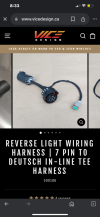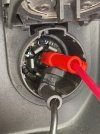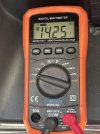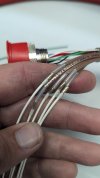5thGenRams Forums
You are using an out of date browser. It may not display this or other websites correctly.
You should upgrade or use an alternative browser.
You should upgrade or use an alternative browser.
REVERSE AUX LIGHTING
- Thread starter 1BADRAMLIMITED
- Start date
1BADRAMLIMITED
Spends too much time on here
1BADRAMLIMITED
Spends too much time on here
To follow this I used some ssc2’s and they work fine from the harness I made for the other lights
Last edited:
jkm312
Well-Known Member
- Joined
- Mar 6, 2019
- Messages
- 315
- Solutions
- 1
- Reaction score
- 332
- Points
- 63
- Age
- 70
I used the same lights as you 3 years ago, still going strong. Only difference is I took the connection from the Kurt plug from the back side of the trailer plug so as not to cut into anything OEM. I did use some Posi-lock connectors I got from Amazon, Di electric greased all the connections as I taped and put them back together. Put everything in lumes, taped and wire tied everything up out of the way.
Ive been following along here. Seems you may have some sort of short/loose connection that went away when you pulled it apart. They are a nightmare to deal with. Could it be mice munching on part of it? At this point you might be just as far ahead to go ahead the rewire everything from scratch and call it a day.
The mice thing has caused me to slug it out with a couple of boat trailers along the way. I understand your frustration.
ref=sr_1_3
Ive been following along here. Seems you may have some sort of short/loose connection that went away when you pulled it apart. They are a nightmare to deal with. Could it be mice munching on part of it? At this point you might be just as far ahead to go ahead the rewire everything from scratch and call it a day.
The mice thing has caused me to slug it out with a couple of boat trailers along the way. I understand your frustration.
ref=sr_1_3
1BADRAMLIMITED
Spends too much time on here
I remade a new harness this go around and this time used a DT connector as well. I put dielectric grease on all connections.I used the same lights as you 3 years ago, still going strong. Only difference is I took the connection from the Kurt plug from the back side of the trailer plug so as not to cut into anything OEM. I did use some Posi-lock connectors I got from Amazon, Di electric greased all the connections as I taped and put them back together. Put everything in lumes, taped and wire tied everything up out of the way.
Ive been following along here. Seems you may have some sort of short/loose connection that went away when you pulled it apart. They are a nightmare to deal with. Could it be mice munching on part of it? At this point you might be just as far ahead to go ahead the rewire everything from scratch and call it a day.
The mice thing has caused me to slug it out with a couple of boat trailers along the way. I understand your frustration.
ref=sr_1_3
In the video you can see the ssc2 work fine but these stupid Amazon ones won’t but I can’t figure out why?!
This is the harness I’m using to pull from the truck power/ground.

It's the chitty Amazon lights. Stop wasting time trying to make them work. NI remade a new harness this go around and this time used a DT connector as well. I put dielectric grease on all connections.
In the video you can see the ssc2 work fine but these stupid Amazon ones won’t but I can’t figure out why?!
This is the harness I’m using to pull from the truck power/ground.
View attachment 188407
1BADRAMLIMITED
Spends too much time on here
But how do you explain them working off the truck on my bench? Tomorrow I’m going to see if they work with reverse polarity, I know some Chinese stuff works like thatIt's the chitty Amazon lights. Stop wasting time trying to make them work. N
Ugh.
All this talk of splicing and soldering.
Crimp (or posilock if you must) and marine grade shrink tubing. A proper crimp will ALWAYS outperform a solder connection. There's a reason everything in the automotive/aircraft/military use crimped connections. I don't mean some cheesy autozone or harbor freight nylon splice crimper, but a proper ratcheting barrel crimp tool with an appropriate sized die.
As to the corrosion. Dielectric grease is preventative. If you have corrosion you need to remove or chemically clean and treat it before reapplying a Dielectric grease.
I prefer the CAIG DeoxIT products. Home - CAIG
If you need to wrap (after selaing), use Tesa tape, not cheap electrical tape. There's heat resistant (exterior) and the "fuzzy" interior wiring loom tape.
All this talk of splicing and soldering.
Crimp (or posilock if you must) and marine grade shrink tubing. A proper crimp will ALWAYS outperform a solder connection. There's a reason everything in the automotive/aircraft/military use crimped connections. I don't mean some cheesy autozone or harbor freight nylon splice crimper, but a proper ratcheting barrel crimp tool with an appropriate sized die.
As to the corrosion. Dielectric grease is preventative. If you have corrosion you need to remove or chemically clean and treat it before reapplying a Dielectric grease.
I prefer the CAIG DeoxIT products. Home - CAIG
If you need to wrap (after selaing), use Tesa tape, not cheap electrical tape. There's heat resistant (exterior) and the "fuzzy" interior wiring loom tape.
Last edited:
1BADRAMLIMITED
Spends too much time on here
I do use crimp connectors when I feel lazy and want to get it done fast vs soldering. I have a crimp tool like you described and proper crimp connectors. I also use 3m electrical tape followed by the mesh tape or if I really want it to be nice I’ll use loom.Ugh.
All this talk of splicing and soldering.
Crimp (or posilock if you must) and marine grade shrink tubing. A proper crimp will ALWAYS outperform a solder connection. There's a reason everything in the automotive/aircraft/military use crimped connections. I don't mean some cheesy autozone or harbor freight nylon splice crimper, but a proper ratcheting barrel crimp tool with an appropriate sized die.
As to the corrosion. Dielectric grease is preventative. If you have corrosion you need to remove or chemically clean and treat it before reapplying a Dielectric grease.
I prefer the CAIG DeoxIT products. Home - CAIG
If you need to wrap (after selaing), use Tesa tape, not cheap electrical tape. There's heat resistant (exterior) and the "fuzzy" interior wiring loom tape.
I work in military aviation, and build custom wire harness all day long. Solder splices are most definitely used, depending on the harness. Granted, crimp splice are more prevalent, but without the proper tools and splices, which are cost prohibitive for most hobbyists, you standard red/blue/yellow barrel splices and ring terminals crimped with the cheap stripper/crimpers combo tools are not desirableUgh.
All this talk of splicing and soldering.
Crimp (or posilock if you must) and marine grade shrink tubing. A proper crimp will ALWAYS outperform a solder connection. There's a reason everything in the automotive/aircraft/military use crimped connections. I don't mean some cheesy autozone or harbor freight nylon splice crimper, but a proper ratcheting barrel crimp tool with an appropriate sized die.
As to the corrosion. Dielectric grease is preventative. If you have corrosion you need to remove or chemically clean and treat it before reapplying a Dielectric grease.
I prefer the CAIG DeoxIT products. Home - CAIG
If you need to wrap (after selaing), use Tesa tape, not cheap electrical tape. There's heat resistant (exterior) and the "fuzzy" interior wiring loom tape.
LaxDfns15
Ram Guru
This goes back to LED lights being sensitive to voltages. Those cheap Amazon lights are just that... cheap. Not trying to get you to buy more expensive lights, I use a crap ton of cheap Amazon stuff. My reverse lights I have wired up to where when they break or fail I can easily swap out replacements with JST connections.
1BADRAMLIMITED
Spends too much time on here
Yea I guess you could make that assumption but they worked great for a good 5-6 months then 1 started holding water so I got a new pair and they no longer work like the previous pair. This time around I made sure to use all the tape, grease and connectors.This goes back to LED lights being sensitive to voltages. Those cheap Amazon lights are just that... cheap. Not trying to get you to buy more expensive lights, I use a crap ton of cheap Amazon stuff. My reverse lights I have wired up to where when they break or fail I can easily swap out replacements with JST connections.
1BADRAMLIMITED
Spends too much time on here
Update on this, I got them to work. All it took was making them run in reverse polarity. No codes no issues, they work fine as before. Not sure why the 1st pair I got wasn’t wired to use reverse polarity????
DEG
Ram Guru
- Joined
- Aug 10, 2023
- Messages
- 945
- Reaction score
- 925
- Points
- 93
- Age
- 63
I work in military aviation, and build custom wire harness all day long. Solder splices are most definitely used, depending on the harness. Granted, crimp splice are more prevalent, but without the proper tools and splices, which are cost prohibitive for most hobbyists, you standard red/blue/yellow barrel splices and ring terminals crimped with the cheap stripper/crimpers combo tools are not desirable
Absolutely. I was an aircraft electrical/environmental systems technician for 21 years while in the Air Force and crimp splices and terminations were considered temporary repairs even though QA often looked the other way when temporary became a very long time. The preferred method for wire repair was to replace the entire run of wire and wires were terminated via soldered connection; normally a cannon plug with soldered pins.
DEG
Ram Guru
- Joined
- Aug 10, 2023
- Messages
- 945
- Reaction score
- 925
- Points
- 93
- Age
- 63
I’m not sure what the issue is. All fuses are good, all pins on the bumper read 14volts ???
I also bench tested both lights to a battery on my work bench and they both work fine….
I think some here are confusing voltage with current (amps). Voltage is simply the potential for current flow but the current is what powers the component. When you said the lights started off being very dim, that sounds like a current issue.
It's entirely possible to have a wire or wire connection where all the strands of the wire are broken except for a single strand of that wire. That single strand is enough for you to read full voltage, but that single strand may not allow enough current flow to operate the light. The most common culprit is a ground wire not making a good connection.
1BADRAMLIMITED
Spends too much time on here
I got them to work . But great thanks for the bit of knowledge you sharedI think some here are confusing voltage with current (amps). Voltage is simply the potential for current flow but the current is what powers the component. When you said the lights started off being very dim, that sounds like a current issue.
It's entirely possible to have a wire or wire connection where all the strands of the wire are broken except for a single strand of that wire. That single strand is enough for you to read full voltage, but that single strand may not allow enough current flow to operate the light. The most common culprit is a ground wire not making a good connection.
theblet
Legendary member
- Joined
- Feb 8, 2021
- Messages
- 6,157
- Reaction score
- 6,022
- Points
- 113
- Age
- 45
Glad they're working! seems like a PITA. Did you have to reverse the wires to test them on the bench?Update on this, I got them to work. All it took was making them run in reverse polarity. No codes no issues, they work fine as before. Not sure why the 1st pair I got wasn’t wired to use reverse polarity????
Not many solder pin cannon plugs used anymore, other than on some heavier guage power harnesses.Absolutely. I was an aircraft electrical/environmental systems technician for 21 years while in the Air Force and crimp splices and terminations were considered temporary repairs even though QA often looked the other way when temporary became a very long time. The preferred method for wire repair was to replace the entire run of wire and wires were terminated via soldered connection; normally a cannon plug with soldered pins.
1BADRAMLIMITED
Spends too much time on here
Yea flipped them around and then re-made the harness. This time the point of failure will be the lights not the harness. Hopefully they hold up last set was dry for 6 months or so then started holding water.Glad they're working! seems like a PITA. Did you have to reverse the wires to test them on the bench?
Users who are viewing this thread
Total: 1 (members: 0, guests: 1)














